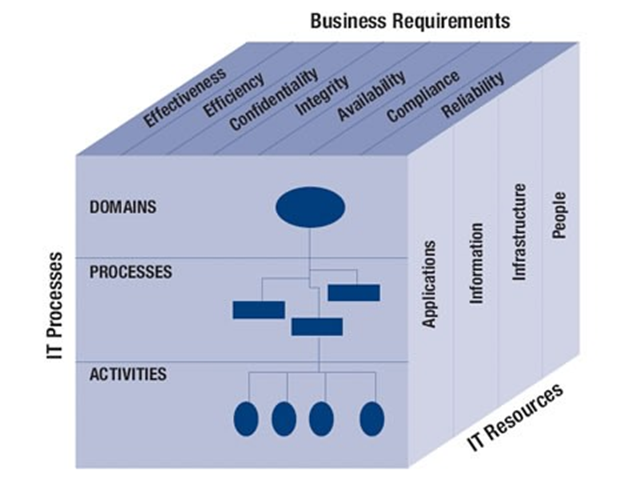What is COBIT? COBIT Explained


IT management abounds with best practice frameworks. These frameworks offer philosophies and tangible paths forward to improve cost and resource management, measure risk, speed up customer service, and innovate analysis through predictive methods.
COBIT is one such best practice framework, but its scope is unique from most frameworks in that it focuses narrowly on security, risk management, and governance. If you’re looking to streamline business processes, sync IT with business needs, alter your IT infrastructure, or manage the multi-cloud, COBIT isn’t the answer.
But with most companies relying enormously on IT for business success – sometimes the IT itself is the product – COBIT is essential to developing, controlling, and maintaining risk and security for enterprises around the world, regardless of your industry.
Short for Control Objectives for Information and Related Technologies, COBIT was first developed to guide IT governance and management. Its latest iteration, COBIT 2019, has revamped parts of its framework while offering much-needed updates that accounts for ever-present cybersecurity threats and the incorporation of Agile and DevOps practices.
This article serves as a primer to the COBIT framework, understanding the meaning of COBIT, and offering guidance on whether it’s the right solution for your enterprise.
Control Objectives for Information and Related Technologies (COBIT) is a framework for managing enterprise IT systems. COBIT is a collection of best practices and principles, along with tools and models for making sure IT resources and processes align with and support business goals. It was first introduced by the Information Systems Audit and Control Association (ISACA) in 1996, and has gone through many rounds of development since.
ISACA stands for the Information Systems Audit and Control Association. This organization was founded in 1969 to support IT professionals in creating IT systems that support the business goals of organizations. ISACA focuses on IT governance, risk management, cybersecurity, and auditing support with standards, guidelines, and best practices.
COBIT offers models to help maximize the value and trust in IT, and these extended guidelines provide security, risk, reward, business and IT consulting professionals with a more extended framework to help in delivering and maintaining enterprise objectives and strategies. Some of the numerous benefits of COBIT are listed below:
International professional association ISACA first released COBIT in 1996 as a set of control objectives to aid the financial auditing community to work better around IT-related structures.
As value and potential beyond auditing became evident, ISACA released a more comprehensive version in 1998 and further expanded it by adding management guidelines in the third version released in the year 2000. Development of the AS 8015: Australian Standard for Corporate Governance of Information and Communication Technology and the ISO/IEC 38500 in January 2005 and January 2007 respectively upped the degree of awareness of the need for reliable information and communication technology (ICT) governance components.
In 2011, ISACA released COBIT 5, which remained the standard for seven years. In November 2018, big changes came to COBIT when ISACA released COBIT 2019.
The latest iteration of COBIT modernizes the framework for the immense expansion of IT within the business world. COBIT 2019 continues to fit in nicely with ITIL, TOGAF, and CMMI, and it serves as a good umbrella framework for unifying processes across an organization.
Within the COBIT Core Model, the heart of COBIT, there are now 40 governance and management objectives. Due to user feedback and IT reliability and needs, COBIT 2019 offers more flexible options for deploying maturity and capability measurements so that IT goals can keep up with data-driven business goals.
According to ISACA, COBIT 2019 has several new goals, too, including but not limited to the following:
The COBIT 2019 guidebooks significantly revamp prior versions, resulting in four key guides:
From the highest level, COBIT creates a three-level structure comprised of the following segments:
The affiliations between these components are exemplified by the COBIT cube.
 All the processes are listed under four domains:
All the processes are listed under four domains:
COBIT business orientation and form of operation comprises of linking business goals to IT goals, providing info metrics and maturity models for ascertaining the level of accomplishments and noting the interrelated responsibilities of business and IT process owners. To completely understand the scope of the mode of operation of the COBIT framework, two main parameters are provided:
There are two distinctive classes of control models available today:
COBIT aims to close the gap that exists between the two.
Apart from being more encompassing for management, COBIT also operates at a higher level than pure technology standards for information systems management. IT governance is defined as a structure put in place to control and direct an enterprise in achieving its goals by adding value while assessing and balancing the risk versus return over IT and its processes. The basic underlying concept of COBIT framework is that control in IT is attaining by focusing on information that is required to support the business objectives or requirements, and by treating the information as a result of the combined application of IT-related resources that need to be managed by IT processes.
The six COBIT principles lay out the important aspects of IT enterprise governance:
COBIT components include:
Because COBIT 2019 is an enterprise framework, three types of people typically engage with the COBIT framework directly:
Though not officially designated, business process owners can use COBIT to render more effective service in controlling IT processes.
Users of COBIT 2019 may seek certification to ensure COBIT compliance within their enterprises. There are three options:
In August 2019, ISACA along with The Institute of Internal Auditors (IIA) is hosting a Governance, Risk, and Control Conference, with pre-conference Bridge certification options.
Enterprise IT managers frequently deploy other IT-specific frameworks and processes. Luckily, COBIT’s concepts and structures play well with other popular options, including:
Uniquely, COBIT places more focus on what to do rather than how to do it, often delegating how-to issues to other tools, frameworks, and methodologies.
All governance frameworks have the same objective: implementing the best operating techniques for minimal financial losses from compliance failures. These frameworks aim to make it easier for enterprises to undergo and pass regulatory audits. Control frameworks and security standards are often exchangeable terminologies.
Taking COBIT’s definitions as a basis for our parameters, COBIT classifies a framework as a Control Framework, which is described as a tool for business process owners that expedites and accelerates the discharge of their responsibilities through the provision of a supporting control model.
| ITIL | COBIT | ISO/IEC 20000 | |
|---|---|---|---|
| What is it? | A set of best practice publications for IT service management | A business framework for the goverance and management of enterprise IT | An international standard for IT service management system requirements |
| How long is it? | Five core publications totalling about 1800 pages, plus complementary publications | Core publication of 94 pages, plus 230 pages for enabling processes, and further publications | Part 1 (service management system requirements) has 36 pages, there are other parts covering other aspects |
| How is it seen in the market? | ITIL has a focus on internal processes. Recent versions have incorporated a service lifecycle and more focus on value and customers | COBIT comes from a history of audit and compliance. The latest version has moved towards IT service governance and management | ISO/IEC 20000 is an international standard, and the main focus is on achieving certification to demonstrate compliance to the standard |
| Who is it generally used by? | Any organization providing internal or external IT services. It is most commonly used in operational IT departments | Internatl IT organizations of large enterprises. COBIT is often used by strategic teams and people responsible for audit and compliance | IT organizations who want to demonstrate that they meet an externally defined standard |
| What is it mainly used for? | Helping to define operational IT service management processes | Defining audit and compliance requirements for IT | Demonstrating that the IT organization meets a recognized standard |
On the other hand, COBIT describes a standard as a business practice or technology product that is generally accepted and endorsed by the enterprise or IT management team. There are various security standards and control frameworks that could easily substitute COBIT even if they are not as effective.
The following are security standards and control frameworks interchangeable with COBIT that can address information security requirements:
As with any framework or best practice protocol, the structure is only that: a path forward. Successful implementation that results in necessary business results for your enterprise rely on a mix of widespread in-house adoption, data-driven analytics, and the right mix of people and culture. Change is not easy and change takes time – both are key factors in whether COBIT can help support your improved IT governance and security. Reading a guidebook or taking a certification course aren’t enough unless the entire enterprise can promote the changes, employees can embrace the new direction, and the COBIT-inspired structure actually fits your company’s needs.
For more on IT frameworks and IT management, check out these BMC Blogs resources: